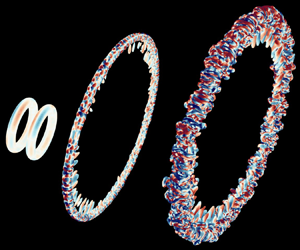Published online by Cambridge University Press: 05 March 2024

We simulate the head-on collision between vortex rings with circulation Reynolds numbers of 4000 using an adaptive, multiresolution solver based on the lattice Green's function. The simulation fidelity is established with integral metrics representing symmetries and discretization errors. Using the velocity gradient tensor and structural features of local streamlines, we characterize the evolution of the flow with a particular focus on its transition and turbulent decay. Transition is excited by the development of the elliptic instability, which grows during the mutual interaction of the rings as they expand radially at the collision plane. The development of antiparallel secondary vortex filaments along the circumference mediates the proliferation of small-scale turbulence. During turbulent decay, the partitioning of the velocity gradients approaches an equilibrium that is dominated by shearing and agrees well with previous results for forced isotropic turbulence. We also introduce new phase spaces for the velocity gradients that reflect the interplay between shearing and rigid rotation and highlight geometric features of local streamlines. In conjunction with our other analyses, these phase spaces suggest that, while the elliptic instability is the predominant mechanism driving the initial transition, its interplay with other mechanisms, e.g. the Crow instability, becomes more important during turbulent decay. Our analysis also suggests that the geometry-based phase space may be promising for identifying the effects of the elliptic instability and other mechanisms using the structure of local streamlines. Moving forward, characterizing the organization of these mechanisms within vortices and universal features of velocity gradients may aid in modelling turbulent flows.